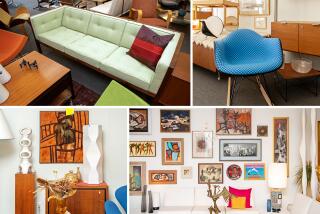Sampling Valley Forge Cornucopia
VALLEY FORGE, Pa. â The Valley Forge area, 18 miles northwest of Philadelphia, offers a chance to visit the site of Revolutionary War history, the grand manor of one of Americaâs great industrialists and the home of perhaps the most famous American art dynasty. In few places is so much history, art, architecture and floral splendor available within a 40-mile radius.
First and foremost, this is Valley Forge Country--site of the encampment of Gen. George Washington and his bedraggled Continental troops in the bitter winter of 1777-78. For six grueling months, the ragtag army roughed it, many without adequate garments, without blankets and without shoes while the British occupied Philadelphia, the American capital.
For the record:
12:00 a.m. July 7, 1991 For the Record
Los Angeles Times Sunday July 7, 1991 Home Edition Travel Part L Page 2 Column 3 Travel Desk 1 inches; 31 words Type of Material: Correction
Du Pont mansion--Due to an editing error, a page-1 caption referring to a story on the Valley Forge area of Pennsylvania misidentified the location of a du Pont mansion. The house is actually across the border in Delaware.
Of all the places associated with the war for independence, none conveys more poignantly the suffering, sacrifice and ultimate triumph as well as Valley Forge National Historical Park. Although no battles were actually fought here, thousands of soldiers died during that wretched winter. Others managed to survive--a heroic struggle against the terrible odds of famine, disease and the ravages of nature.
It is all here: The painful history of the park, covering 3,600 acres, with re-creations of the crowded, smoke-filled log huts that slept 12 soldiers each. Officers were billeted in back, with eight sharing the same stark quarters as the enlisted men.
Some distance beyond in the park is the Isaac Potts House, a revolutionary version of the Pentagon that Washington rented for six months and paid for out of his own pocket.
In another area of the park, engraved on the impressive National Memorial Arch, the Arch of Victory, are Washingtonâs words, from Feb. 16, 1778: âNaked and starving as they are, we cannot enough admire the incomparable patience and fidelity of the soldiery.â
Exhibits in the museumâs visitor center include a variety of items depicting life during encampment days: cooking utensils, surgical instruments, more than 200 muskets, rifles and swords. A regularly scheduled bus tour, featuring taped narrations, stops at key locations. Maps for self-guided routes are also available.
Not far away in Kennett Square, 30 miles southwest of Philadelphia, is Longwood Gardens, the country estate of the late Pierre S. du Pont, great-grandson of the man who founded the du Pont gunpowder company. The grounds surrounding it are an endless cavalcade of exquisite bloom on 350 acres, ranging from formal flower beds complemented by carved stonework and pools to natural woodlands dotted with wildflowers.
In the main conservatory--a majestic crystal palace of sorts, with arched windows and interior columns--and adjoining greenhouses are 3 1/2 acres of heated, indoor gardens. Lush tropical plants, palms, orchids, ferns, cacti and coffee trees thrive year-round--spectacular horticultural displays that form one of the nationâs largest continual indoor flower shows.
Supplementing the floral splendor of 11,000 different kinds of plants, ballroom concerts, open-air theater, dramatic fireworks and a water display called the Festival of Fountains add irresistible dimension. During the 30-minute fountain program on Tuesday, Thursday and Saturday summer nights, illuminated waters, projecting 130 feet into the air, pirouette fancifully to the sounds of classical music.
Du Pont, who died in 1954, once confessed that he was always fascinated by flowing waters. He designed the gardens himself without the aid of professionals. More than half of the 27 rooms of his home are open to the public in self-guided tours. (For more information, write Box 501, Kennett Square, Pa. 19348-0501, or phone 215-388-6741.)
Five miles northeast at Chadds Ford, the Brandywine River Museum--housed in a converted Civil War-era grist mill, with rough plaster walls and hand-hewn beams--contains the largest collection of paintings by three generations of the famed Wyeth family, as well as the output of more than 100 other noted American artists.
Many of Andrew Wyethâs works, exhibited only here, are showcased in the four galleriesâ changing exhibits. Paintings by his father, N.C. Wyeth, who gained wide recognition for portrayals of the American West, include his celebrated cowboys and Indians.
A cobblestone courtyard is studded with patterns of ancient millstones. Glass-walled lobbies offer splendid views of the river and surrounding countryside while nature trails wind through woodlands and 25 acres of meadow containing more than 300 species of plants. The museum is open daily, except Christmas, from 9:30 a.m. to 4:30 p.m., Route 1 South, Chadds Ford, 19317, (215) 388-7601.
Nearby, in Worcester, is the Peter Wentz Farmstead where George Washington was headquartered before and after the Battle of Germantown, while a third of Continental troops were deployed in surrounding properties. A restoration project presents the house as it was in the fall of that year, 1777, although the building was completed almost two decades earlier.
In the living room, side and arm chairs are covered in a bold black-and-white check not commonly associated with muted colonial themes, but accurate according to careful investigation. The screen in front of the fireplace prevented the melting of facial wax, worn by women of that period. Contrary to the myth of a big, roaring fire, it was usually small so petticoats wouldnât ignite.
The upstairs chamber where Washington planned the Battle of Germantown was regarded with such reverance by all the owners, who wanted it to remain undisturbed, that it has received only one coat of paint in 187 years . . . or so the legend goes. Corner and wall cupboards and paneling came with the house, the same for the color scheme--turquoise blue with salmon on the inside of the doors. Two walnut chairs retain their original leather upholstery and brass tacks. The Peter Wentz Farmstead is open Tuesday through Saturday, 10 a.m. to 4 p.m., Sunday 1 to 4 p.m. Write P.O. Box 240, Worcester, Pa. 19490, or call (215) 584-5104.
About four miles northeast on Weikel Road is the medieval-style Morgan Log House, built in 1695 by Edward Morgan, a wealthy wool exporter whose youngest daughter Sarah was the mother of Daniel Boone, the famous frontiersman. Another descendant was Lowell Thomas, celebrated journalist and explorer.
Exterior horizontal logs of red oak and pine were mortared with stone set in a rare diagonal pattern. In this 10-room home, 90% of the construction dates back to its beginning.
Here the Morgans and their 10 children enjoyed an upper-class lifestyle, with fine linens, imported furniture and servants. The giant hearth in the dining hall retains many of the original beams and latches. The house is furnished with early-18th-Century antiques from the Philadelphia Museum of Art, the Dietrich Foundation and the Finkelstein Collection. Open April through November, Monday to Friday by appointment; Saturday and Sunday, 1 to 4 p.m. Write P.O. Box 261, Kulpsville, Pa. 19443, or call (215) 368-2480.
About 15 miles southwest on Horse Shoe Trail Road, midway between Paoli and Valley Forge, is the unusual studio-residence of sculptor Wharton Esherick, who, during his lifetime, was considered one of the deans of American craftsmen. Set high on a wooded hillside, the building, its creative contents and grounds have been kept much as they were when the artist lived and worked here from 1926-1970. On exhibit are more than 200 examples of Esherickâs paintings, woodcuts, prints and sculptures in wood, stone and ceramics.
Best known for sculptural furniture and furnishings, he carved the doors, forged the hinges and shaped the copper sinks of his studio, which he started building without blueprints in 1926. For 15 years it had no plumbing. The house was one of the first passive solar structures in Pennsylvania. His friends--most of them from the world of literature rather than art--included Theodore Dreiser, who worked on âAn American Tragedyâ at Esherickâs kitchen table, and Sherwood Anderson, who asked Esherick to design his tombstone. Reservations are required for the guided tours provided every Saturday and Sunday, March through December. Call (215) 644-5822.
Across the Delaware, 45 minutes from Valley Forge, is Hagley, an outdoor museum where the du Ponts began their manufacture of gunpowder in 1802, eventually supplying explosives for the Army and Navy. Providing an exceptional glimpse into American industrial life of the 19th Century, the grounds cover 230 acres along the banks of the Brandywine River, with 60 structures preserved.
Exhibits and dioramas at the Henry Clay Mill trace the economic and technological expansion of the region and the nation, from small, water-powered mills to giant steam and electric power plants. At the Millwright Shop, an exhibit of working models illustrates the powder-making process.
Overlooking the remains of the old powder yard is the 1803 mansion of Eleuthere Irenee du Pont, the industrialist who founded du Pont. Known as Eleutherian Mills, the home contains furnishings that belonged to the family and the generations that followed. Rooms on the first floor are essentially the same as E.I. du Pontâs great-granddaughter Louise left them. Upstairs are Federal, Empire and Victorian rooms reflecting the tastes of the earlier du Ponts.
To the front of the house is the restored 19th-Century French garden planted by E.I. du Pont, with flower beds and paths forming geometric designs bordered by dwarf fruit trees. On the creek side is the 20th-Century classical garden designed by Louise, incorporating the ruins of ancient mill buildings.
There is an automobile exhibit on the lower level of the stone barn, built the same year as the house and enlarged to current size in 1844. Displayed on the second floor are a Conestoga wagon, carriages and other 19th-Century vehicles, as well as a collection of weather vanes, agricultural tools and a cooper shop that supplied barrels and kegs for du Pont products.
About a 10-minute walk up Blacksmith Hill is the restored 1840 Gibbons-Stewart House, where plant foremen and their families lived, typical of better homes built in the half-dozen workersâ communities within walking distance of the powder yards. At one time, row houses sharing common walls crowded hillsides on both sides of the Brandywine.
The white-frame Belin House, circa 1818, where company bookkeepers and accountants resided, now serves as a coffee shop for visitors. Across the road, the one-story stone Brandywine Manufacturerâs Sunday School, completed in 1817, provided the only formal education available to mill workersâ children, with classes held each Sunday.
Hagley is open daily, 9:30 a.m. to 4:30 p.m., April through December, with the same hours January through March, but only on weekends. For more information, write P.O. Box 3630, Wilmington, Del. 19807, or call (302) 658-2400.
GUIDEBOOK
Valley Forge
Where to stay: Among many hotels in the Valley Forge area are: Comfort Inn in King of Prussia, telephone (800) 222-0222; rates $49 and up. Great Valley Hilton and Conference Center in Malvern, indoor pool, fitness center, tennis courts, complimentary buffet breakfast, (800) 445-8667; $65 and up. Sheraton Valley Forge in King of Prussia, outdoor pool, exercise room, steam room, sauna, (800) 325-3535; $95 and up. Guest Quarters Suite Hotels in Wayne and Plymouth Meeting, (800) 424-2900; $150 and up.
Where to eat: Chadds Ford Inn (Martha Washington ate here), Route 1 and 100, Chadds Ford, Pa. 19317, (215) 388-7361. Baronâs Inn, 499 N. Gulph Road, King of Prussia 19406, (215) 265-2550. Lily Langtryâs, Sheraton Valley Forge. Kennedy Supplee Restaurant, Route 23, on grounds of Valley Forge Park, housed in 1852 mansion, (215) 337-3777. Pastabilities, Route 202, King of Prussia, (215) 265-8772.
For more information: Contact the Valley Forge Convention & Visitors Bureau, Box 311, Norristown, Pa. 19404, (800) 441-3549 or (215) 278-3558.
More to Read
Sign up for The Wild
Weâll help you find the best places to hike, bike and run, as well as the perfect silent spots for meditation and yoga.
You may occasionally receive promotional content from the Los Angeles Times.






